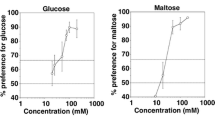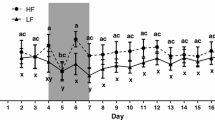Abstract
Ruminant herbivores have been shown to learn about food properties by associating food flavours with the food’s post-ingestive consequences. Previous experimentation supporting the conditioned food aversion/preference hypothesis has generally employed very simple diet learning tasks which do not effectively represent the wide range of foods selected within single bouts typical of wild, free-ranging ruminant herbivores. We tested the ability of a ruminant herbivore to associate a food with artificially administered nutrient rewards in a designed experiment where we altered the temporal pattern of encounter with the food as well as the nature (fast or slow reward) of the post-ingestive outcome. Twenty-four goats were offered branches of Sitka spruce (SS) and Norway spruce (NS) for 4 h per day on two days per week for five weeks. The pattern of feeding varied with treatment such that the species on offer changed every hour (short) or every 2 h (long). The energy treatment altered the reward delivered during Sitka consumption so that animals were dosed either with predominantly sugar (rapidly fermented), predominantly starch (slower fermentation rate), or with water (placebo). Preference was measured on the day following each learning day. We expected that goats would find it easier to associate SS with post-ingestive rewards when the duration of encounter was longest, and that associations would be stronger with the most rapidly digested post-ingestive reward. In the event, goats did not alter their consumption of SS in response to the treatments. Our results suggest that at the scale of temporal resolution of encounters with different plant species (1–2 h), and at the different rates of experiencing post-ingestive consequences tested in this experiment, ruminants do not appear to discriminate the nutritive properties of foods predominantly through a post-ingestive feedback mechanism. They must, instead, use a range of cues—including post-ingestive consequences—to assess food properties.





Similar content being viewed by others
References
Agreil C, Meuret M (2004) An improved method for quantifying intake rate and ingestive behaviour of ruminants in diverse and variable habitats using direct observation. Small Rumin Res 54:99–113
Agricultural Research Council (1980) The nutrient requirements of ruminant livestock. Commonwealth Agricultural Bureaux, Farnham Royal, Slough, UK
Arnold GW (1981) Grazing behaviour. In: Morley FW (ed) Grazing animals. Elsevier, Amsterdam, pp 79–104
Arsenos G, Kyriazakis I (1999) The continuum between preferences and aversions for flavoured foods in sheep conditioned by administration of casein doses. Anim Sci 68:605–616
Bazely DR (1990) Rules and cues used by sheep foraging in monocultures. In: Hughes RN (ed) Behavioural mechanisms of food selection. Springer, Berlin, pp 343–367
Chase LE, Wangsness PJ, Kavanaugh JF, Griel LC, Gahagan JH (1977) Changes in portal blood metabolites and insulin with feeding steers twice daily. J Dairy Sci 60:403–409
de Jong A (1981) Short- and long-term effects of eating on blood composition in free-feeding goats. J Agric Sci 96:659–668
Duncan AJ, Young SA (2002) Can goats learn about foods through conditioned food aversions and preferences when multiple food options are simultaneously available? J Anim Sci 80:2091–2098
Duncan AJ, Hartley SE, Iason GR (1994) The effect of monoterpene concentrations in Sitka spruce (Picea sitchensis) on the browsing behaviour of red deer (Cervus elaphus). Can J Zool 72:1715–1720
Duncan AJ, Ginane C, Gordon IJ, Orskov ER (2003) Why do browsing herbivores select mixed diets? In: ’t Mannetje L, Ramirez-Aviles L, Sandoval Castro CA, Ku Vera JC (eds) Matching herbivore nutrition to ecosystems biodiversity (Proc VI Int Symp on the Nutrition of Herbivores, Merida, Mexico, 19–24 Oct 2003). Universidad Autonoma de Yucatan, Merida
Duncan AJ, Young SA, Thoss V, Elston DA (2005) Browse selection in response to simulated seasonal change in diet quality through post-ingestive effects. J Chem Ecol 31:729–744
Duncan AJ, Ginane C, Elston DA, Kunaver A, Gordon IJ (2006) How do herbivores trade-off the positive and negative consequences of diet selection decisions? Anim Behav 71:93–99
Ginane C, Duncan AJ, Young SA, Elston DA, Gordon IJ (2005) Herbivore diet selectivity in response to simulated variation in nutrient rewards and plant secondary metabolite concentrations of food plants. Anim Behav 69:541–550
Illius AW, Gordon IJ (1992) Diet selection in mammalian herbivores-constraints and tactics. In: Hughes RN (ed) Diet selection. Blackwell, Oxford, pp 157–181
Lucas PW, Turner IM, Dominy NJ, Yamashita N (2000) Mechanical defences to herbivory. Ann Bot 86:913–920
MAFF (1975) Energy allowances and feeding systems for ruminants (Technical Bulletin 33). HMSO, London
Mazur JE (1994) Learning and behavior. Prentice Hall, Englewood Cliffs, NJ
Menke KH, Raab L, Salewski A, Steingass H, Fritz D, Schneider W (1979) Estimation of the digestibility and metabolizable energy content of ruminant feedingstuffs from the gas-production when they are incubated with rumen liquor in vitro. J Agric Sci 93:217–222
Meuret M, Bruchou C (1994) Modélisation de l’ingestion selon la diversité des choix alimentaires réalisés par la chèvre au pâturage sur parcours (Modelling voluntary intake related to dietary choices diversity in goat grazing on rangeland). Rencontres Rech Rumin 1:225–228
Provenza FD (1995) Postingestive feedback as an elementary determinant of food preference and intake in ruminants. J Range Manage 48:2–17
Ramirez RG, Quintanilla JB, Aranda J (1997) White-tailed deer food habits in northeastern Mexico. Small Rumin Res 25:141–146
Senft RL, Coughenour MB, Bailey DW, Rittenhouse LR, Sala OE, Swift DM (1987) Large herbivore foraging and ecological hierarchies. Bioscience 37:789–799
Stephens DW, Krebs JR (1986) Foraging theory. Princeton University Press, Princeton, NJ
Van Wieren SE (1996) Do large herbivores select a diet that maximizes short-term energy intake rate? For Ecol Manage 88:149–156
Villalba JJ, Provenza FD (1996) Preference for flavored wheat-straw by lambs conditioned with intraruminal administrations of sodium propionate. J Anim Sci 74:2362–2368
Villalba JJ, Provenza FD (1997) Preference for wheat straw by lambs conditioned with intraruminal infusions of starch. Br J Nutr 77:287–297
Villalba JJ, Provenza FD (2000) Discriminating among novel foods: effects of energy provision on preferences of lambs for poor-quality foods. Appl Anim Behav Sci 66:87–106
Yearsley J, Villalba JJ, Gordon IJ, Kyriazakis I, Speakman JR, Tolkamp BJ, Illius AW, Duncan AJ (2006) A theory of associating food types with their post-ingestive effects. Am Nat 167:705–716
Acknowledgements
This work was funded by the Scottish Executive Environment and Rural Affairs Department. Thanks to Jackie Potts (Biomathematics and Statistics Scotland) for advice on statistical analysis.
Author information
Authors and Affiliations
Corresponding author
Additional information
Communicated by Jean-Michel Gaillard.
An erratum to this article can be found at http://dx.doi.org/10.1007/s00442-007-0898-5
Rights and permissions
About this article
Cite this article
Duncan, A.J., Elwert, C., Villalba, J.J. et al. How does pattern of feeding and rate of nutrient delivery influence conditioned food preferences?. Oecologia 153, 617–624 (2007). https://doi.org/10.1007/s00442-007-0771-6
Received:
Accepted:
Published:
Issue Date:
DOI: https://doi.org/10.1007/s00442-007-0771-6




